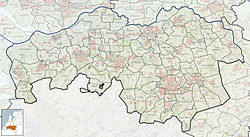Vught
| Vught | |||
|---|---|---|---|
| Town and municipality | |||

Church in Vught
|
|||
|
|||
| Coordinates: 51°39′N 5°18′E / 51.650°N 5.300°ECoordinates: 51°39′N 5°18′E / 51.650°N 5.300°E | |||
| Country | Netherlands | ||
| Province | North Brabant | ||
| Government | |||
| • Body | Municipal council | ||
| • Mayor | Roderick van de Mortel (VVD) | ||
| Area | |||
| • Total | 34.44 km2 (13.30 sq mi) | ||
| • Land | 33.48 km2 (12.93 sq mi) | ||
| • Water | 0.96 km2 (0.37 sq mi) | ||
| Elevation | 5 m (16 ft) | ||
| Population (May 2014) | |||
| • Total | 25,769 | ||
| • Density | 770/km2 (2,000/sq mi) | ||
| Demonym(s) | Vughtenaar | ||
| Time zone | CET (UTC+1) | ||
| • Summer (DST) | CEST (UTC+2) | ||
| Postcode | 5260–5266 | ||
| Area code | 0411, 073 | ||
| Website | vught |
||
Vught (Dutch pronunciation: [vɵxt]) is a municipality and a town in the southern Netherlands. Many commuters live in the municipality, and the town of Vught was once named "Best place to live" by the Dutch magazine Elsevier.
Dutch topographic map of the municipality of Vught, June 2015
The first mention of Vught in the historical record dates to the eleventh century. By the fourteenth century, the Teutonic Order had acquired the parish and set up a commandery (feudalism) across from the Saint Lambert Church. In 1328, the residents of Vught were granted the right of municipality by the Duke of Brabant.
During the Eighty Years War Vught was the site of struggles between Catholic interests and the troops of William of Orange. The Saint Lambert Church was made into a Reformed Protestant church in the year 1629, after the troops of Frederick Henry, Prince of Orange, were victorious in 's-Hertogenbosch.
Vught is known for having been the site of a transit/concentration camp (Herzogenbusch) built by Nazi Germany during its occupation of the Netherlands in World War II. It was part of camp Herzogenbusch, but usually better known as "Kamp Vught" (Camp Vught). The camp held male and female prisoners, many of them Jewish and political activists, captured in Belgium and the Netherlands. The guard staff included SS men and a few SS women, headed by Oberaufseherin Margarete Gallinat. The SS initially used this location as a transit camp to gather mostly Jewish prisoners for classification and transportation to camps in Poland and other areas.
...
Wikipedia





